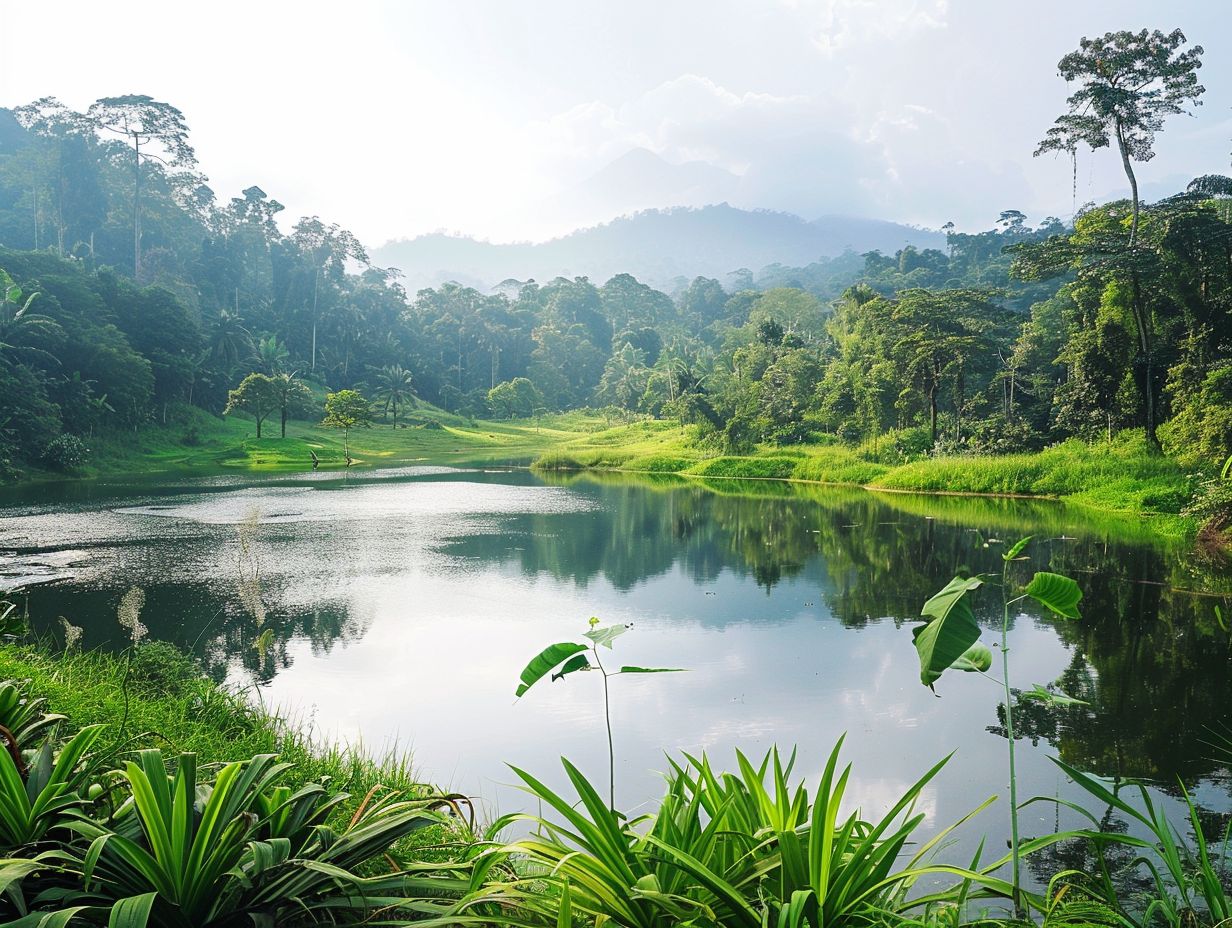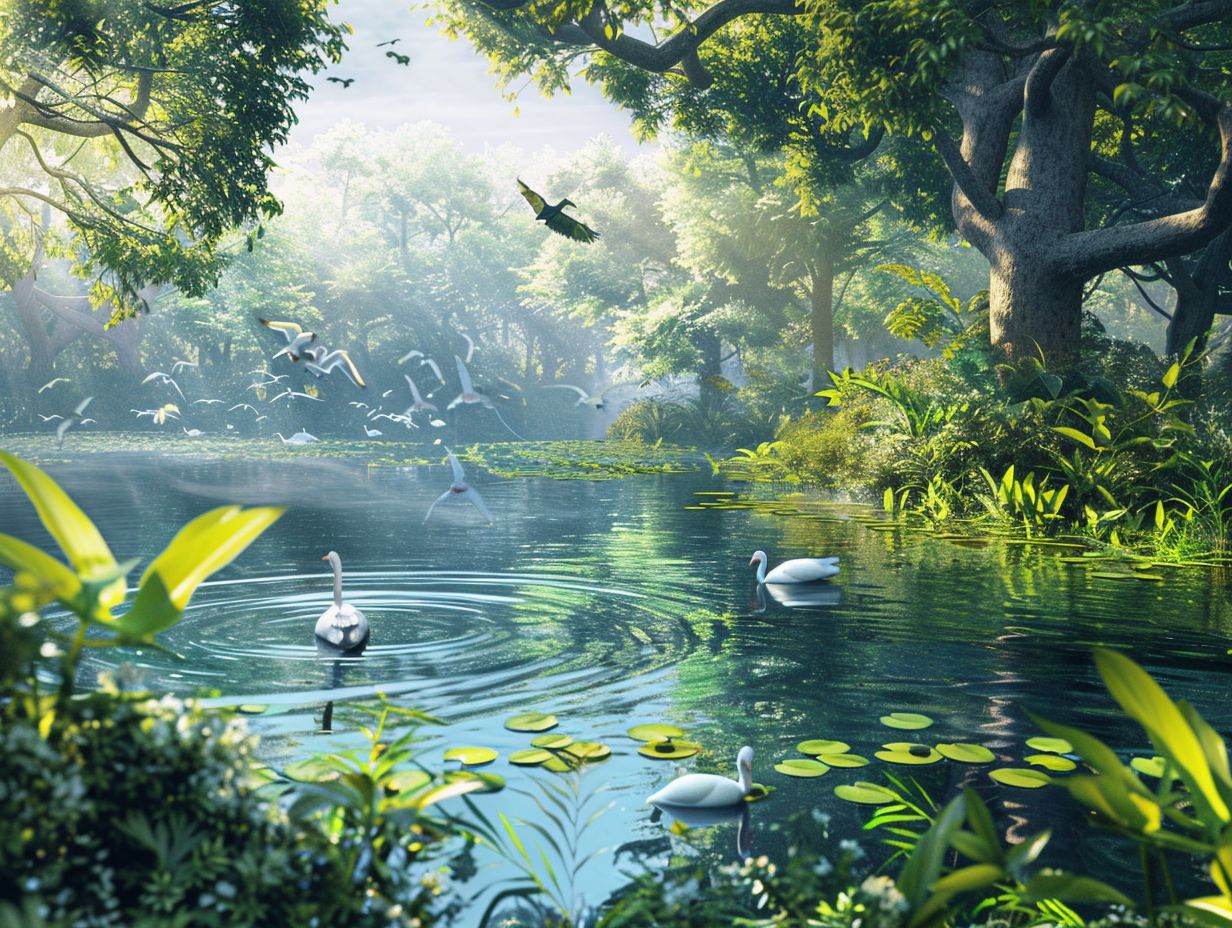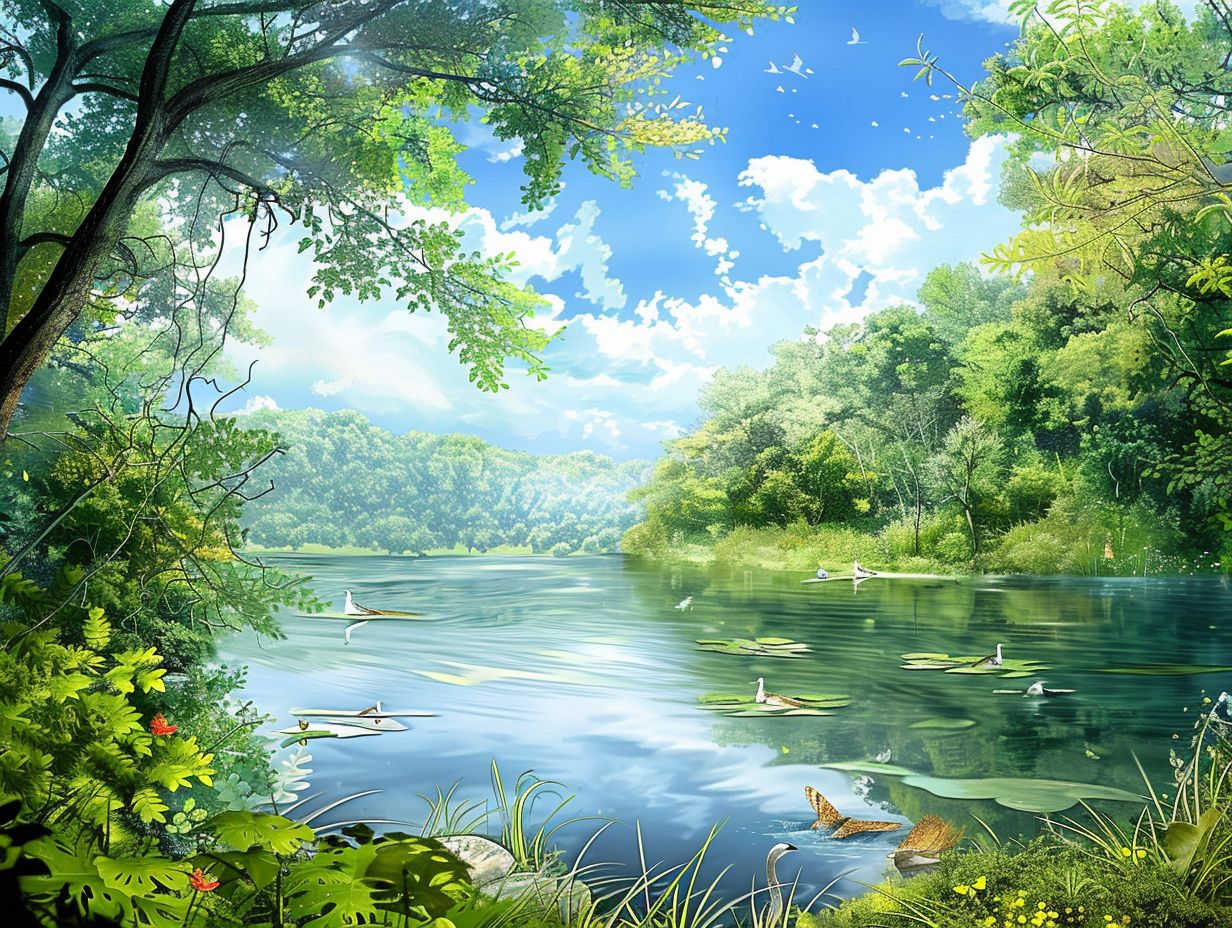
Lake Manyara
Located in Tanzania, Lake Manyara is a stunning gem nestled at the base of the Great Rift Valley.
This article will explore the geographical features of Lake Manyara, including its size and depth.
We will delve into the rich flora and fauna of the area, highlighting the diverse wildlife that can be found in Lake Manyara National Park.
From activities for visitors to conservation efforts, we will cover everything you need to know about this breathtaking destination.
Key Takeaways:

- Lake Manyara is located in northern Tanzania, just south of the Serengeti National Park.
- With a size of 127 square miles and a depth of up to 2.3 miles, Lake Manyara offers a diverse landscape and ecosystem.
- The national park is home to a variety of wildlife, including elephants, giraffes, and over 400 species of birds.
Location and Geography of Lake Manyara:
Lake Manyara National Park, located in the Arusha Region of Tanzania, is a breathtaking National Park known for its diverse wildlife, stunning landscapes, and serene lake views. The park is nestled between the Great Rift Valley and the Ngorongoro Highlands, offering a unique blend of habitats and ecosystems.
The park’s location at the base of the Rift Valley escarpment provides a stunning backdrop of dramatic cliffs, forests, and open savannah. Lake Manyara itself covers about two-thirds of the park’s total area and is fed by underground springs and the Simba River. The variety of environments within the park, from the lush groundwater forest to the dry acacia woodlands, supports a wide range of plant and animal species, including the famous tree-climbing lions.
-
Where is Lake Manyara Located?
Lake Manyara National Park is situated in the Arusha Region of Tanzania, within the Manyara Region. It is positioned along the shores of Lake Manyara, providing a picturesque setting for visitors to explore and discover the rich biodiversity of the area.
The park’s location near Lake Manyara contributes significantly to its allure, as it attracts a wide array of wildlife species due to the availability of freshwater and abundant vegetation.
This proximity allows visitors to witness diverse wildlife such as elephants, hippos, and a variety of bird species in their natural habitat. The park’s landscape is enhanced by the Great Rift Valley escarpment, offering stunning views and unique photographic opportunities for tourists to capture the beauty of the region.
-
What is the Size and Depth of Lake Manyara?
Lake Manyara, the centerpiece of the national park, spans a considerable area, providing a vital water source for the surrounding ecosystem. The lake’s depth varies throughout the year, influenced by seasonal patterns and sedimentation processes.
Lake Manyara covers approximately 230 square kilometers, making it one of the smaller lakes in the region. Its average depth ranges from 3 to 4 meters; however, during the rainy season, it can reach depths of up to 5 meters. The influx of water from rivers and streams during this time significantly contributes to the lake’s depth fluctuations.
The sedimentation processes in Lake Manyara play a crucial role in its composition and clarity. Sediments carried by inflowing rivers settle at the bottom, affecting the lake’s transparency and nutrient levels. Despite this, the lake remains a haven for diverse bird species, including flamingos, pelicans, and herons.
Flora and Fauna of Lake Manyara:
Lake Manyara National Park boasts a remarkable diversity of flora and fauna, showcasing a vibrant tapestry of wildlife species, lush vegetation, and picturesque landscapes. Visitors to the park can witness a spectacular array of birds, mammals, and fish thriving in their natural habitats.
The park is well-known for its unique vegetation, ranging from dense groundwater forests to open savannahs, creating a variety of habitats for its inhabitants. Rich in biodiversity, Lake Manyara is home to over 400 bird species, including the iconic pink-hued flamingos that flock to its alkaline waters.
The park’s tree-climbing lions are a rare sight, adding to its mystique and allure. Other indigenous mammals such as elephants, giraffes, zebras, and hippos can also be spotted roaming the plains or cooling off in the lake’s sparkling waters, providing a truly immersive safari experience.
-
What Animals Can Be Found in Lake Manyara National Park?

Lake Manyara National Park is home to a diverse array of wildlife species, including iconic African mammals such as elephants, lions, zebras, and giraffes. Visitors can embark on thrilling safari adventures to observe these majestic creatures in their natural habitat.
The park is renowned for its tree-climbing lions that can often be spotted resting on branches during the day. Lake Manyara National Park is famous for its large herds of elephants that roam the vast plains, along with zebras and giraffes gracefully moving through the savannah.
Conservation efforts within the park are crucial for the protection of these species, as elephants, lions, and zebras are classified as vulnerable or near-threatened by the International Union for Conservation of Nature (IUCN).
-
What Birds Can Be Spotted at Lake Manyara?
Lake Manyara is a paradise for bird enthusiasts, with over 400 avian species gracing the skies and trees of the park. Birdwatchers can delight in observing flamingos, hornbills, and various migratory birds in their natural environment.
The park is renowned for its diverse bird population, attracting birdwatchers from around the world. The diverse habitats within Lake Manyara National Park, ranging from the alkaline lake shores to dense groundwater forests, provide ideal conditions for a wide range of bird species to thrive.
Some of the iconic resident bird species that call the park home include the pink-hued flamingos that create a stunning sight as they gather in the shallow waters. Meanwhile, the melodious calls of the vibrant hornbills echo through the trees, adding a symphony of sounds to the park’s ambiance.
During the migratory seasons, the park becomes a hub of activity as countless birds make their journey to or from distant lands. Nestled within the Great Rift Valley, the park serves as a crucial stopover for these migratory birds, offering them a sanctuary to rest and refuel.
Among the popular birdwatching sites in the park, the groundwater forests stand out as prime locations to spot a variety of avian species. The canopy provides shelter to numerous birds, showcasing unique behaviors such as intricate mating rituals, playful interactions, and graceful flights.
Conservation efforts are in place to safeguard the avian diversity of Lake Manyara National Park. Education programs, habitat restoration initiatives, and community engagement work towards maintaining a harmonious balance between human activities and the preservation of the park’s rich birdlife.
-
What Vegetation Can Be Found at Lake Manyara?
The vegetation of Lake Manyara National Park encompasses lush forests, acacia woodlands, and open grasslands, providing a diverse habitat for a wide range of wildlife species. Visitors can explore the park’s botanical wonders and witness the intricate relationships between plants and animals.
Within the park, numerous plant species showcase remarkable adaptability to thrive in these varied ecosystems, from the towering mahogany trees in the dense forests to the iconic umbrella-shaped acacias in the woodlands. These plants play a vital role in supporting the park’s delicate ecosystem, offering food and shelter to a myriad of wildlife, from elephants browsing on leaves to birds nesting in the branches.
Activities and Attractions at Lake Manyara:
Lake Manyara offers a diverse range of activities and attractions for tourists seeking an unforgettable wildlife experience. From thrilling safaris and birdwatching expeditions to cultural explorations and nature walks, visitors can immerse themselves in the beauty and splendor of the park.
One of the highlights of visiting Lake Manyara is the opportunity to witness the stunning array of wildlife up close. With its diverse ecosystems, the park boasts a rich variety of animals, including elephants, hippos, zebras, and the famous tree-climbing lions. Guided tours offer a unique chance to learn about the park’s flora and fauna from experienced professionals, while cultural interactions with the local Maasai people provide a deeper insight into the region’s traditions and way of life.
-
What Can Visitors Do at Lake Manyara?
Visitors to Lake Manyara National Park can partake in thrilling safari adventures to witness the park’s wildlife up close, embark on guided nature walks to explore its diverse habitats, and engage in cultural interactions with local communities. The park offers a multitude of activities for tourists seeking an immersive wildlife experience.
Aside from the exciting safari drives, visitors at Lake Manyara National Park can also enjoy leisurely guided nature walks, allowing them to observe the intricate details of the park’s flora and fauna. These walks provide a more intimate experience with nature, offering a chance to learn about the smaller, often overlooked aspects of the ecosystem.
For those interested in delving deeper into the local culture, guided cultural visits are available, giving tourists the opportunity to interact with indigenous tribes such as the Maasai and experience their traditional way of life.
Photography enthusiasts are in for a treat at Lake Manyara National Park, as the picturesque landscapes and diverse wildlife offer countless opportunities for capturing stunning images. Guided tours can help visitors locate the best spots for photography and provide insights on capturing the perfect shot while respecting the park’s conservation guidelines.
-
What Are the Most Popular Attractions at Lake Manyara?

Some of the most popular attractions at Lake Manyara include the diverse wildlife sightings during safaris, the stunning views of Lake Manyara itself, the lush vegetation that supports a variety of species, and the engaging cultural experiences offered within the park. These attractions draw tourists from around the world to immerse themselves in the wonders of nature.
One of the remarkable aspects of Lake Manyara National Park is the incredible array of wildlife that inhabits the area, providing visitors with unforgettable encounters with elephants, giraffes, zebras, and the famous tree-climbing lions. Wildlife enthusiasts are delighted by the bird-watching opportunities, with over 400 bird species recorded in the park, making it a paradise for bird lovers.
The breathtaking scenery of the park contributes to its allure, from the shimmering waters of the lake to the majestic backdrop of the Great Rift Valley. The scenic beauty is unparalleled, offering a serene and picturesque setting for visitors to explore.
For those interested in cultural immersion, Lake Manyara National Park provides unique opportunities to interact with the local Maasai communities, gaining insight into their traditional way of life and participating in traditional dances and rituals. These cultural experiences add a deeper dimension to the overall visitor experience, creating lasting memories and promoting cultural understanding.
-
What Are the Best Times to Visit Lake Manyara?
The best times to visit Lake Manyara National Park are during the dry season (June to September) when wildlife congregates around water sources, and the rainy season (November to May) when the landscape transforms into a lush paradise. Each season offers unique experiences for visitors seeking a wildlife adventure.
During the dry season, visitors can enjoy unparalleled wildlife sightings as animals gather near the diminishing water sources, making for excellent game viewing opportunities. The sparse vegetation during this period also enhances visibility, allowing for clear sightings of iconic species such as elephants, lions, and giraffes.
On the other hand, the rainy season brings a different charm to Lake Manyara National Park. The landscape flourishes with vibrant greenery, creating a picturesque backdrop for birdwatching enthusiasts. This time of the year is ideal for witnessing a plethora of bird species, with migratory birds adding to the diversity of the park’s avifauna.
Understanding the climate variations is crucial for planning a memorable visit to Lake Manyara National Park. The dry season guarantees thrilling wildlife encounters, while the rainy season offers a greener and more serene atmosphere for nature lovers to explore and appreciate the park’s biodiversity.
Conservation Efforts at Lake Manyara:
Lake Manyara National Park is dedicated to conservation efforts aimed at protecting its diverse wildlife species, preserving the fragile ecosystem, and mitigating threats to the natural environment. The park implements various protection measures to safeguard its flora, fauna, and landscapes for future generations.
Wildlife protection at Lake Manyara National Park goes beyond conservation of individual species; it involves preserving the delicate balance of the entire ecosystem. The park faces several threats, such as habitat loss, poaching, and human-wildlife conflicts.
To counter these challenges, the park has adopted innovative conservation strategies like community engagement, habitat restoration, and anti-poaching patrols. Visitors play a crucial role in supporting these efforts through responsible tourism practices, educational programs, and financial contributions that directly fund conservation projects.
-
What Threats Does Lake Manyara Face?
Lake Manyara faces various threats to its wildlife and ecosystems, including habitat loss, human-wildlife conflicts, poaching, and climate change impacts. These challenges endanger the park’s biodiversity and necessitate proactive conservation measures to ensure the preservation of its natural treasures.
Habitat loss poses a significant risk to the diverse flora and fauna found within Lake Manyara National Park. As human populations expand and agricultural activities encroach upon the park’s boundaries, crucial habitats are being fragmented and degraded, disrupting the delicate balance of the ecosystem. Poaching further exacerbates this issue, targeting iconic species like elephants and rhinos for their tusks and horns, putting them at the brink of extinction.
-
What Conservation Efforts Are in Place at Lake Manyara?
Lake Manyara implements conservation measures such as anti-poaching patrols, habitat restoration projects, community outreach programs, and sustainable tourism practices to protect its ecosystem and wildlife species. These efforts aim to ensure the long-term sustainability of the park’s natural resources and promote responsible tourism.
Along with these crucial initiatives, Lake Manyara National Park has been actively involved in fostering partnerships with local communities to engage them in conservation efforts.
Through collaborative projects, the park not only educates residents on the importance of preserving the environment but also give the power tos them to take an active role in safeguarding the biodiversity. By involving the community in decision-making processes and providing alternative livelihood opportunities, the park creates a sense of ownership and responsibility towards the protection of the park’s ecosystem.
The park’s anti-poaching efforts are extensive, with dedicated teams conducting regular patrols to deter poachers and protect the wildlife within the park. These patrols, equipped with necessary training and technology, play a crucial role in safeguarding endangered species from illegal hunting activities and ensuring a safe environment for the park’s inhabitants.
-
How Can Visitors Support Conservation at Lake Manyara?

Visitors to Lake Manyara can contribute to conservation efforts by practicing responsible tourism, respecting park regulations, supporting local sustainability initiatives, and spreading awareness about environmental conservation. By actively engaging in conservation-friendly behaviors, tourists can play a vital role in protecting the park’s natural heritage.
One key aspect of responsible tourism is minimizing waste generation and adhering to recycling protocols within the park premises.
Following designated walking trails and avoiding off-road driving helps preserve sensitive habitats and reduce human impact on wildlife.
Purchasing locally-made crafts and products further supports the economic sustainability of nearby communities, fostering a symbiotic relationship between tourism and local residents.
By taking part in guided educational tours, visitors gain a deeper appreciation for the park’s biodiversity and conservation efforts, give the power toing them to become informed ambassadors for wildlife protection.
Frequently Asked Questions:
1. What is Lake Manyara?
A: Lake Manyara is a shallow lake located in the northern part of Tanzania, near the city of Arusha. It is known for its unique ecosystem and diverse wildlife.
2. What is the size of Lake Manyara?
A: Lake Manyara covers an area of approximately 230 square kilometers and has a maximum depth of 3.7 meters.
3. What type of animals can be found at Lake Manyara?
A: Lake Manyara National Park is home to a variety of animals including elephants, giraffes, buffaloes, hippos, and a large number of bird species.
4. Is it possible to go on a safari at Lake Manyara?
A: Yes, visitors can go on a safari at Lake Manyara National Park to see the diverse wildlife and beautiful landscapes. Safaris can be arranged through various tour companies.
5. What is the best time to visit Lake Manyara?
A: The best time to visit Lake Manyara is during the dry season from June to September, when animals gather around the lake and are easier to spot. However, the park is open year-round.
6. Are there any accommodations near Lake Manyara?
A: There are various accommodation options near Lake Manyara, including campsites, lodges, and luxury tented camps. It is recommended to book in advance, especially during peak season.